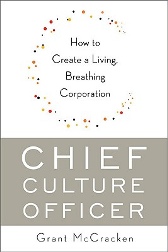
Chief Culture Officer: How to Create a Living, Breathing Corporation
by Grant McCracken
-Reviewed by Adam Fleisher
 Anthropologist Grant McCracken thinks that every corporation needs a chief culture officer. The CCO, rather than eyeballing finances or performance like his peers at the top of the corporate heap, would keep an eye on “culture, both its fads and its fashions, and its deep, enduring structures.” If the role seems slightly nebulous, that’s because it is. When McCracken is trying to sell the reader on the virtues of the CCO, he has a hard time getting past metaphors and turns of phrase.
Anthropologist Grant McCracken thinks that every corporation needs a chief culture officer. The CCO, rather than eyeballing finances or performance like his peers at the top of the corporate heap, would keep an eye on “culture, both its fads and its fashions, and its deep, enduring structures.” If the role seems slightly nebulous, that’s because it is. When McCracken is trying to sell the reader on the virtues of the CCO, he has a hard time getting past metaphors and turns of phrase.
But there is clearly a relationship between culture and commerce that companies can harness, and McCracken is at his best when he focuses on that relationship. Chief Culture Officer isn’t an elevation of the hipster or the elite tastemaker – in fact, just the opposite, and its egalitarian bent is refreshing.
McCracken observes that the demise of high-status tastemakers means that preferences, interests and desires are created by popular culture, not fed to it. On television, for example, smarter and more engaged viewers encouraged smarter culture. Dialogue is richer; shows quote themselves and insert in-jokes and cross-references to appeal to the dedicated viewer. Once upon a time, McCracken notes, popular culture had taken “extraordinary pains to see that the viewer was never puzzled or confused.” Popular tastes emanated from a few executives at a few studios. But with the proliferation of mediums, and the growing sophistication of new generations of consumers, “dumbing down” and “pandering” to the masses no longer works. Viewers demand narrative complexity and creativity, and they get it from shows ranging from the X-Files to Buffy the Vampire Slayer to Lost.
And executives haven’t just been replaced by self-made arbiters of hip. McCracken disdains the “cool-hunters,” as Malcolm Gladwell once called them, who “frequently confuse being informed with being hip.” These experts tend to think they are aware of the latest in cool culture. Yet they are dismissive of culture that is genuinely popular, whether hip or otherwise. Cool (American Apparel, Kanye West’s sunglasses) is not the same thing as culture (swap meets, gardening, NASCAR and the stuff hipsters are into).
McCracken’s examples of what a CCO could do – like helping Coca Cola grasp the importance of diversifying from Coke into branded water and other non-carbonated soft drinks; telling Kraft that it was late to the South Beach Diet party; or warning Martha Stewart about the coming of Rachel Ray – are scattered throughout the book as case studies of errors that could have been avoided if somebody was paying attention to culture.
But the clearest example of the importance of corporate cultural awareness comes from a great case study in mistaking cool for culture: Tropicana’s redesigned juice cartons. The old cartons had an orange with a straw stuck in it; the new ones had a more modern design, with a close-up of juice in a glass and a cap shaped like an orange. McCracken lauds the theory the Tropicana designer relied on – to “rejuvenate, reengineer, rethink, reparticipate in popular culture.” But he went looking for that popular culture in “trendy design houses,” and not among the people. Consumers actually disliked the new packaging so much that sales dropped off considerably, and Tropicana went back to the old design. “This is the trouble with gurus,” writes McCracken, “They don’t much care about American culture. What they care about is what other incredibly hip people think about culture.”
A CCO would know better than to browse such a narrow slice of society in order to figure out what would resonate amongst the masses. And if an expert or consultant were hired for some sort of rebranding project, the CCO would make sure he didn’t forget to look at how ordinary Americans actually live. That is, companies should figure out who their customers are, treat them well, and provide them with what they want.
Excerpt: “The CCO works in support of the chief executive officer. And the CEO is Zeusian. Hers is the head from which the corporation springs. The CCO’s job is to figure out how to insinuate cultural knowledge into the CEO’s head. This can be tricky because the CEO is often a senior male, who defines and exercises his intelligence as something that cuts through noise and nonsense to get at the fact of the matter. To this man, culture often looks like noise and nonsense. . . . The conventional CEO has a degree in accounting, engineering, or economics. He went to a business school where no culture was taught, and he now lives in AmericanExpressPlatinumLand….”
Further Reading: Nation of Rebels: Why Counterculture Became Consumer Culture and The Conquest of Cool: Business Culture, Counterculture, and the Rise of Hip Consumerism
*Photo courtesy 96dpi.




Send A Letter To the Editors